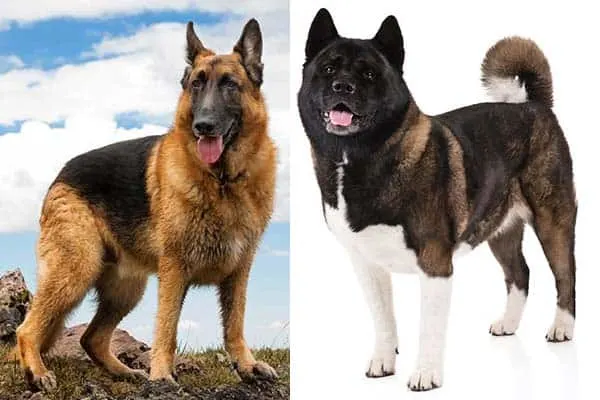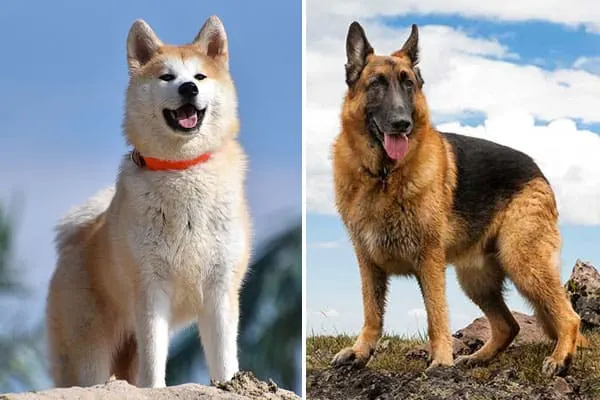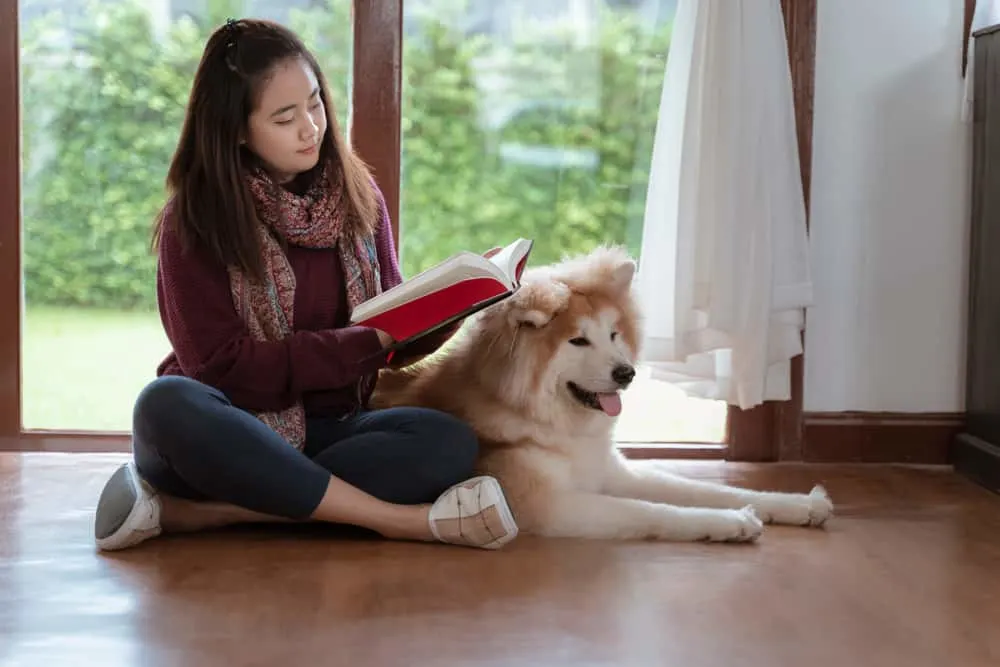German Shepherd Akita Mix: The Versatile Family Dog You Need!
Do you ever wonder why dogs like German Shepherds and Poodles are so popular and have remained so for decades?
Or why do most breeds experience surges and declines in public demand?
Fads certainly play a role, but there’s also a concern for poor breeding and detrimental features that purebreds so often seem to exaggerate.
As scrutiny on purebred dogs increases from the media and dog lovers alike, mixed-breed canines are rising in demand.
Designer dog breeders try to focus on specific desirable traits and often end up choosing the GSD or Poodle to mix their pups with.

One designer dog that may accomplish the lofty aspiration of improving two breeds simultaneously is the Shepkita.
A cross between a German Shepherd and an Akita, the Shepkita, or Akita Shepherd accentuates power, intelligence, loyalty, guarding, and utility.
Combining breeds similar in appearance and versatility, and divergent in background and motivation, the German Shepherd Akita mix makes an intriguing working dog and dedicated family companion.
In this article, we’ll discuss the Shepkita’s historical origins, behavior around other dogs, social potential, guarding capacity, grooming needs, and general health.
Akita German Shepherd Mix: Meet The Parents
Your German Shepherd Akita Mix will inevitably have intense focus, a strong work ethic, and versatility.
You’ll be able to perform many types of activities together, including police and military work, agility, jogging, search and rescue, obedience, and show exercises.
A herding dog from Germany
The German Shepherd originated from sheepherding dogs across Germany.
Max von Stephanitz, a prominent member of a school of dog fanciers who wanted to promote purity, went to great lengths to develop the perfect working dog in 1899.
He found what he considered an ideal model in the successful show dog Hektor.
Generations of careful breeding made the German Shepherd type unmistakable and its versatility world-renowned. The breed became a member of the herding group of the AKC in 1908.
A hunting dog from Japan
At one time you actually needed the privilege of Japanese royalty to own an Akita.
Historical sources romanticize the Akita’s origins as a hunting dog from the Northern mountains of Japan.
While early Akitas did hunt large game like boars and bears, they also had a strong dogfighting heritage.
Japanese owners began breeding their medium-sized Akitas with Mastiffs and Tosas to increase their size and competitiveness against other dogs in the mid-1600s, according to the Akita Association of Ireland.
Interestingly, the idea of the German Shepherd Akita Mix isn’t new. During World War II, the two breeds’ histories would intersect.
To conserve food supplies, Japan decreed all dogs should be surrendered for their pelts, which would line soldiers’ clothing.
However, the country spared any German Shepherd serving on the police force.
Desperately seeking to save their beloved breed, some owners hid their dogs while others took the drastic step of crossing them with German Shepherds.
In this video, these two puppies undoubtedly come from the same litter. Note how much they look like Shepherds, and the sable and fawn coloration possible in a single litter.
Their Akita traits are more apparent when they stand at attention.
Their similarity to the German Shepherd stems from the World War II crisis in Japan, as this is how owners were able to ensure their survival.
The Akita is a national treasure and a natural monument in Japan.
The first Akita to come to the United States was a gift from the Japanese government to Helen Keller in 1937. Akitas joined the AKC in 1972 as working dogs.
Can You Predict The Appearance of an Akita German Shepherd Mix?
Size and general appearance are predictable.
The Shepkita will be quite large, but probably somewhat smaller than an Akita, weighing 65 to 100 pounds.
A Shepherd is 24 to 26 inches tall and weighs 50 to 90 pounds, while an Akita male can reach 28 inches in height and weigh 90 to 130 pounds (about 20% larger than a female).
In this video, the mix is a seemingly perfect blend of the Akita and German Shepherd.
It’s black and tan with white, the tail only partially curled, and the head somewhere between the length of a Shepherd’s and the ‘blockiness’ of an Akita’s.
The Shepkita’s body is sturdy and well-balanced, and they’re super friendly.
A Shepherd Akita mix inherits upright ears from both parents as well as a plush double coat, a medium to long tail with varying degrees of curling, and a muscular broad chest.
It’ll be slightly longer than it is tall, and the ears are typically set further forward than a Shepherd’s and more triangular in shape.
German Shepherds are substantially longer than they are tall with ground-covering strides and remarkable stamina. Their ears are large and open, and their eyes slightly almond-shaped and brown.
A Shepherd’s tail is moderately long and carried low when relaxed. The neck is long, the head narrow, and the jaws slightly square.
An Akita will have smaller ears angled about 20 degrees forward of the vertical plane.
It has a wedge-shaped head with a shorter muzzle than the Shepherd. Its tail is also shorter and is carried curled over the back.
Akitas have a variety of tail sets, from a double curl to just a half-moon draped and reaching the mid-back. The Akita appears square and high off the ground compared to a GSD.
An Akita’s defining features are a black mask on the face and a full, curled tail.
The only acceptable colors are red fawn, white, or brindle. Red fawn dogs with black tips are sesame.
As a quick aside, many countries recognize two distinct breeds of Akita, the Akita Inu and the American Akita.
The United States doesn’t distinguish between Akita types and therefore boasts the highest numbers of Shepkitas.
The UK recognizes a Japanese Akita and the Akita, refusing to acknowledge the name, American Akita.
What colors can the hybrid be?
Shepherd-Akita mixes can be the colors of either breed or a few colors beyond the typical spectrum:
- Black and tan – GSD
- Black – GSD
- Blue – GSD
- Fawn – Akita or GSD
- Tan – GSD or Akita
- Red and white – Akita
- Brindle – Akita
- White – GSD or Akita
- Sable – GSD
- Merle – not seen in the purebred Akita or Shepherd
- Pinto – Akita. Pinto is a large proportion of white with splotches of color over a third of the body in an organized pattern. Pinto Akitas usually still have a black facial mask, although sometimes split by white down the middle.
- White with black spots or freckles – atypical of either Akitas or German Shepherds. Solid white purebred dogs of the two breeds don’t have spots.
Shepkitas, except solid white dogs, will often have facial masks. Black masks aren’t readily apparent on black or brindle dogs.

How difficult Will My Akita German Shepherd Mix Be To Train?
There’s a good chance that your Shepherd mix will be easier to train than a purebred Akita.
Just how stubborn or strong-willed your puppy becomes depends on what proportion of genetic factors it inherits from each parent.
Keep in mind that your pup has the potential to inherit domineering tendencies from either or both parents.
German Shepherds are generally easy to train, although they can have issues with dominance. However, once you gain Shepherd’s respect, they tend to be quite obedient.
Akitas are willful, strong-minded, and independent. While clearly very smart, they seem to ponder commands before executing them.
Akitas, like other Spitz breeds, also tend to wander and don’t always listen to commands asking them to come back.
Is The Akita German Shepherd Mix aggressive? Are They Good Watchdogs?
You shouldn’t have any doubts regarding your Shepherd Akita’s ability to guard your home and family. Prepare yourself for potential aggression against perceived threats.
Early training and socialization are crucial so that your dog can become a reasonable and discerning judge of strangers.
Experts recommend focusing more on teaching obedience rather than guard training with a Shepherd or an Akita.
Canines with natural guarding tendencies don’t need additional training or encouragement to be more aggressive – this can create a dangerous dog.
German Shepherds have courage, boldness, and fierceness that have placed them among the best guard dogs.
Not specifically bred for aggression, their hostility against intruders comes from protective instincts first cultivated through their work with livestock.
They extend that protection to all family members and are territorial over the home and property.
Akitas, like Shepherds, are loyal and courageous.
However, they’re more similar to the Doberman in that their breeders developed aggressive tendencies for the primary role of guarding people and property.
Their ferocity against intruders is inherent and uncompromising. Akitas, according to TheNest, won’t tolerate animals or human visitors if you aren’t home.
Grooming Requirements May Take Some Time
Your German Shepherd Akita Mix will likely require brushing every day.
Their double coat will be thick with the outer guard hairs probably medium in length. A slicker brush will remove loose dirt, and dead fur/skin cells.
Your dog will need a bath if soil build-up becomes severe. Use a mild shampoo to help prevent irritation and keep the skin from becoming too dry.
Clip nails at least once every six weeks and check ears regularly.
A long-haired German Shepherd will rarely not have an undercoat. Usually, a Shepherd has thick fleece underfur near the skin, with a medium to long outer layer of coarse hair.
Akitas also have a double coat, although their fur is often shorter, thicker, and softer than the German Shepherd’s.
Neither dog requires clipping of their coats. Often, shaving your Shepkita’s fur disrupts their ability to regulate their core temperature.

How Does The Akita German Shepherd Mix Do In Different Types of Weather?
Your Shepkita will have a thick undercoat that insulates it from the sun and keeps it warm during the winter.
Several states have passed laws that prevent you from leaving your dog for prolonged periods outdoors when the temperature dips below freezing.
Some dog houses now provide safe means to install a pet heater when it becomes extremely frigid in the winter.
No matter how much you winterize your dog’s environment, or how much your Shepkita loves the snow, leaving it unattended outdoors can lead to emotional and social problems.
The German Shepherd and Akita do, however, both thrive in cold conditions.
Their undercoats provide excellent insulation, and their longer outer fur acts as a water repellent to keep them dry. Despite this, a shelter may still be needed.
German Shepherds also tolerate the heat somewhat better than Akitas.
When temperatures exceed 85 to 90 degrees Fahrenheit, try to limit exercise, provide plenty of water, and move walks to mornings or late evenings when it’s cooler.
Akita German Shepherd Mix Health Issues
Both purebred Akitas and Shepherds have health problems they can pass along to any offspring. They share several issues in common.
Both Breeds
- Hip dysplasia – developmental disorders of the hip joint that can cause progressively worsening discomfort throughout the dog’s life. Your veterinarian may recommend surgical intervention in some cases.
- Hypothyroidism – The thyroid gland functions below normal levels, requiring supplementation.
- Elbow dysplasia
- Hemangiosarcoma – A cancerous growth on the spleen that can cause chronic bleeding.
- Epilepsy – Seizure disorder
German Shepherd
- Hemophilia – A specific clotting factor is absent
- Diabetes – A disorder that affects the regulation of blood sugar
Akita
- Von Willebrand’s – Affects a different clotting factor than Hemophilia
- Myasthenia Gravis – According to VCA Hospitals and other veterinary sources, usually an acquired autoimmune disease that disrupts chemical signals between nerves and muscles.
- Autoimmune skin diseases
Akita German Shepherd Mix
According to Globaldogbreeds, the Shepherd Akita mix has picked up a few unique health problems not commonly cited in the research of German Shepherds or Akitas.
- Luxating patella – More often associated with small dogs, the American College of Veterinary Surgeons reports that luxating patellas appear to be on the rise in dogs like the Akita and Flat-Coated Retriever.
- Lupus – Likely from the Akita’s genetic predisposition to autoimmune disorders.
How long will your Akita Shepherd live?
Akitas, German Shepherds, and Shepkitas all have similar life spans – the Shepherd lives 10 to 13 years, according to Shepped.
The Shepkita is also reported to live 10 to 13 years and the Akita 10 to 15 years.
German Shepherd Akita Mix Exercise Requirements
A Shepkita will likely require amounts of exercise that fall between what a German Shepherd needs and an Akita needs.
German Shepherds, with their intense single-minded focus and exceptional stamina, need mental stimulation as well as sessions of rigorous activity.
Akitas tolerate shorter bursts of exertion, but still need about 30 to 45 minutes of exercise per day, according to Animalwised.
You need to incorporate training with both of these breeds, and the earlier you can start, the better.
How Will Your Akita German Shepherd Mix Fit In With The Family?
Shepkitas are most likely to be kind and protective of children in their household, if socialized from a young age. They may or may not tolerate other animals.
You may not see dog aggression appear in your pup until it approaches adolescence, or around six to eight months of age.
Both Akitas and German Shepherds can learn to see children as part of their pack that they need to protect, and around whom they must be gentle.
Akitas cannot be trusted to extend that solicitous attitude to children outside of the family. You shouldn’t leave dogs, especially large ones, unsupervised with small children.
German Shepherds and Akitas have a strong prey drive. You shouldn’t tempt Akitas by leaving them in the close vicinity of pet birds or small dogs.
Some Akitas befriend cats, but their volatile play energy warrants extreme caution.
Is The German Shepherd Akita Mix The Right Dog For You?
The Shepherd Akita mix is potentially a great family companion. Like most large dogs, it requires early socialization and firm training.
It’s an affectionate pet, a natural guard dog, and athletic. You can enjoy several activities together like flyball, fetch, agility training, obedience exercises, and hiking.
Shepkitas probably do best if they’re the only animal in the household.
If you have plenty of quality time to spend with a large and strong-minded dog, a Shepherd Akita mix may fit your family perfectly.
FAQ:
1. What is the Shepkita breed and what are its characteristics?
Answer: The Shepkita is a cross between a German Shepherd and an Akita, known for accentuating power, intelligence, loyalty, guarding, and utility. It makes an intriguing working dog and dedicated family companion with intense focus, a strong work ethic, and versatility.
2. What is the history of German Shepherds and Akitas?
Answer: German Shepherds originated from sheepherding dogs across Germany and were developed to a perfect working dog by Max von Stephanitz in 1899. Akitas were originally a hunting dog from the Northern mountains of Japan and were bred for its competitive nature.
3. What health issues should I be aware of for my Shepherd Akita mix?
Answer: Both purebred Akitas and Shepherds have health problems they can pass along to any offspring. They share hip dysplasia, hypothyroidism, elbow dysplasia, hemangiosarcoma, and epilepsy. The breed also has some unique health issues such as Luxating patella and lupus.
4. How do I groom my Shepherd Akita mix?
Answer: Your Shepkita will likely require brushing every day and a bath if soil build-up becomes severe. Use a mild shampoo to help prevent irritation and keep the skin from becoming too dry. Clip nails at least once every six weeks, and check ears regularly.
5. Is the German Shepherd Akita mix the right dog for me?
Answer: If you have plenty of quality time to spend with a large and strong-minded dog, a Shepherd Akita mix may fit your family perfectly. It’s an affectionate pet, a natural guard dog, and athletic. Nonetheless, it may not be the right dog for households with other animals, and early socialization and training are crucial.






























